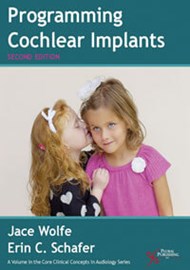Wolfe and Schafer open their second edition with up-to-date images of brand-specific devices and show various configurations and customisations available to the recipient. For the audiologist, they introduce highly relevant topics such as polar plots for microphones, array types and device design, and an understanding of the differences between the offerings from the “Big Three”. It must be noted that newer manufacturers are not discussed however, and since publication, there has been some significant progress in device features from the main manufacturers in the last five years.
Brand-specific information is provided in separate chapters, a feature which helps a clinician new to cochlear implants get familiar with brand-specific software, terminology, features, and historical processor names. This makes it an easy-to-use reference book when considering clinical approaches. The authors quickly move into the underpinning knowledge of strategies and psychophysics with an approach that shows the need for discovering recipient preferences, and highlighting the uniqueness of their programming but also the technicalities relating to the implant array and device. Chapter seven discusses a holistic view of implant programming with discussion on collaboration with surgical teams, suggested timelines for care, and delves into considerations for rehabilitation which highlights the need for optimal programming, but also the need for specialised therapy.
The experienced clinician may find help regarding counselling on poor outcomes, and discussing ‘red flags’ that are impeding progress, in the later stages of the book. In particular, there are three pages of helpful psychoacoustic troubleshooting, which are provided in a table format with a minimum of five approaches provided for each concern.
Electro-acoustic devices are discussed with examples of Real Ear measures correlating to electrode allocations, something I haven’t seen in literature previously. However, despite the provision of technical information, there is very little about the specifics of hybrid programming.
Of particular interest are 15 case studies running the reader through from creating a basic programme, using objective measures for fitting, programming for a one-year-old child, addressing speech perception concerns from over-stimulation for a young child, and four electrode impedance cases with different causes.
Overall, this is a book sufficiently heavy on detail, yet does not feel overly technical for a new clinician to learn from. It provides the principles that underpin cochlear implant programming yet approaches the topic in a manner that highlights patient needs, something I think all clinicians will appreciate. Whilst many other books in the field discuss other aspects of implants, the primary focus by Wolfe and Schafer here is on the programming principles, and this alone would make it a helpful reference for clinicians. As an introductory textbook for a clinician interested in cochlear implants, this book would be rated 4/5, with the case studies providing that extra value. I can see this book being of use to a clinician new to the CI field, yet referenceable for a more experienced clinician.




